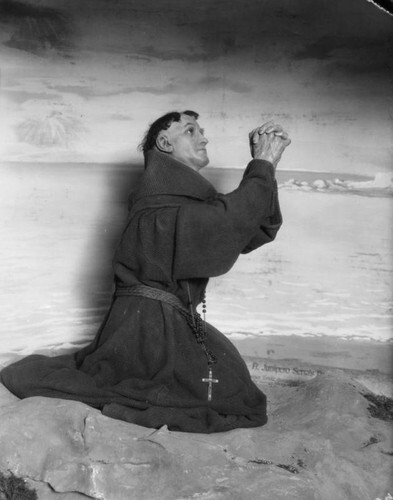Title
Mannequin Of Fr. Juni´Pero Serra - Ramona Outdoor Play, Hemet
Creator
Description
Hemet is a city in Riverside County that was founded in 1887 and incorporated on January 20, 1910 with 992 people. Members of the Cahuilla Indian tribe first inhabited the area. During the early 1800s, it became a cattle ranch for Mission San Luis Rey, which named the area Rancho San Jacinto. In 1895, the Hemet Dam was completed on the San Jacinto River creating Lake Hemet and providing a reliable water supply to the San Jacinto Valley. Despite a severe drought in 1898-1900 and a major Christmas Day earthquake in 1899, the town of Hemet continued to prosper. Every year since 1923 one of the city's claims to fame has been "The Ramona Pageant", an outdoor play based on Helen Hunt Jackson's novel "Ramona". In 1950, Hemet was home to 10,000 people; as of January 2007, the city had a population of 70,288 according to the California Department of Finance.
Title supplied by cataloger.
View of a mannequin depicting Fr. Juni´pero Serra, a key figure of the famed Ramona Outdoor Play in the colorful Ramona Bowl in Hemet. The novel, set in Southern California shortly after the Mexican-American War, follows the life of Ramona, a part-Scottish, part-Indian orphan girl that is raised by her foster mother's sister, Sen~ora Gonzaga Moreno. The Indian maiden Ramona falls in love with Alessandro, a young Indian sheepherder who is also the son of the Chief of the tribe. Soon after, Ramona and Alessandro elope to the chagrin of Sen~ora Gonzaga Moreno; have a daughter; endure hardship and misery; with Alessandro eventually losing his mind and being killed, leaving Ramona to find a new love in Felipe Moreno, Sen~ora Gonzaga Moreno's only son. This immensely popular novel has had more than 300 printings, has been made into four film versions, and has been performed as an annual outdoor play since 1923, with only brief interruptions during the Depression and during World War II. The people of Hemet and San Jacinto have presented this spectacular dramatization of Helen Hunt Jackson's immortal love story, which is said to take place on the actual locale of the historical facts in the play.
Subject
Type
image
Format
Contributor
Access Rights
Image is displayed for education and personal research only. For individual rights information about an item, please check the “Description” field, or follow the link to the digital object on the content provider’s website for more information. Reuse of copyright protected images requires signed permission from the copyright holder. If you are the copyright holder of this item and its use online constitutes an infringement of your copyright, please contact us by email at rhizomes@umn.edu to discuss its removal from the portal.
